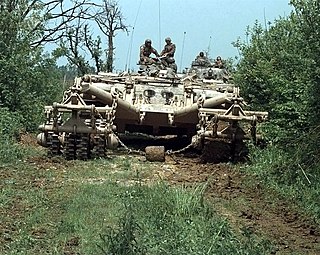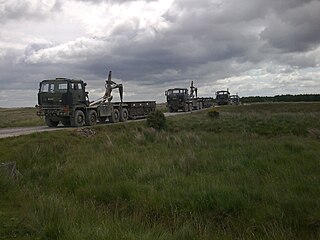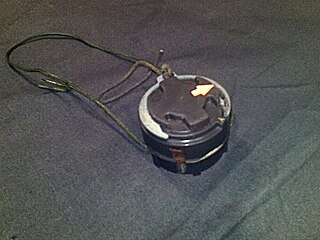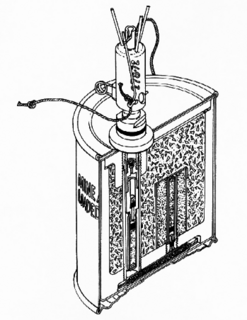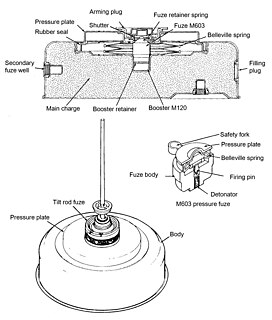| L10 Ranger anti-personnel mine | |
|---|---|
 L10 Ranger anti-personnel mine & arming key | |
| Type | Anti-personnel mine |
| Place of origin | United Kingdom |
| Service history | |
| Used by | United Kingdom |
| Specifications | |
| Mass | 136 grams (4.8 oz) |
| Height | 30 millimetres (1.2 in) |
| Diameter | 60 millimetres (2.4 in) |
| Filling | phlegmatized RDX |
| Filling weight | 109 grams (3.8 oz) |
The L10 Ranger Anti-Personnel Mine was a United Kingdom anti-personnel blast mine. It was used from the 1970s until recently.

Anti-personnel mines are a form of mine designed for use against humans, as opposed to anti-tank mines, which are designed for use against vehicles. Anti-personnel mines may be classified into blast mines or fragmentation mines, the latter may or may not be a bouncing mine.
It was designed to be used in conjunction with the L9 Bar Mine anti-tank mine, to make anti-tank minefields more difficult for enemy sappers to clear by hand. A FV432 would be fitted with a plough through which bar mines would be laid. A firing frame which held 18 clips of 4 barrels each would be fitted to the top of the vehicle. Each barrel contained 18 Ranger mines, for a total of 1,296 mines. The frame could fire in any direction (although mines were not usually fired over the front of the vehicle). As each section of the anti-tank minefield was completed, several of the barrels would be fired. A small propelling charge would launch the mines, scattering them 50 to 250 metres (160 to 820 ft) behind or to the side of the mine-laying vehicle. The act of launching the mine from the tube would release a spring-loaded safety catch and start a timer which would arm the mine after 30 seconds.
The L9 Bar Mine is a large rectangular British anti-tank landmine. The bar mine's principal advantage is its long length, and therefore its trigger length. A typical anti-tank landmine is circular, and a vehicle's wheels or tracks, which make up only a small proportion of its total width, must actually press on the mine to activate it. To increase the probability of a vehicle striking the mine, the mine's effective trigger width must be increased.

A sapper, also called pioneer or combat engineer, is a combatant or soldier who performs a variety of military engineering duties such as breaching fortifications, demolitions, bridge-building, laying or clearing minefields, preparing field defenses, as well as working on road and airfield construction and repair. They are also trained to serve as infantry personnel in defensive and offensive operations. A sapper's duties are devoted to tasks involving facilitating movement, defence and survival of allied forces and impeding those of enemies. The term "sapper" is used in the British Army and Commonwealth nations, Polish Army and the U.S. military. The word "sapper" comes from the French word sapeur, itself being derived from the verb saper.

The FV432 is the armoured personnel carrier variant of the British Army's FV430 series of armoured fighting vehicles. Since its introduction in the 1960s, it has been the most common variant, being used for transporting infantry on the battlefield. In the 1980s, almost 2,500 vehicles were in use, with around 1,500 now remaining in operation - mostly in supporting arms rather than front-line infantry service.
The mine was roughly the size of a tin of shoe polish, made of plastic and coloured olive green. There was enough metal in their fuze to make them detectable. [1] Two inert training versions were available. One was bright orange to allow it to be easily spotted and recovered; the other was made from bio-degradable compressed peat.

Shoe polish is a waxy paste, cream, or liquid used to polish, shine, and waterproof leather shoes or boots to extend the footwear's life, and restore, maintain and improve their appearance.

Biodegradation is the breakdown of organic matter by microorganisms, such as bacteria and fungi.

The Ranger mine laying system could also be fitted to a four-tonne truck, Stalwart High Mobility Load Carrier or the combat support boat
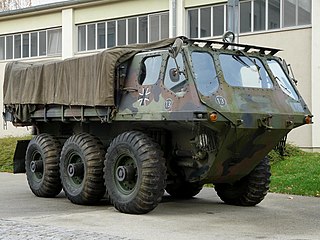
The Stalwart, formally classified by the British Army as Truck, High Mobility Load Carrier (HMLC), 5 Ton, 6 x 6, Alvis/Stalwart and informally known by servicemen as the Stolly, is a highly mobile amphibious military truck built by Alvis that served with the British Army from 1966 until 1992.
The mines were supplied by Thorn EMI and most [lower-roman 1] were supplied before 1986. [2] In June 1998, stocks of 1,110,000 mines were held. [2]
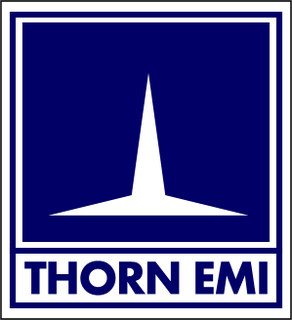
Thorn EMI was a major British company involved in consumer electronics, music, defence and retail. Created in October 1979 when Thorn Electrical Industries merged with EMI, it was listed on the London Stock Exchange and was once a constituent of the FTSE 100 Index but it demerged back to separate companies in 1996.
In accordance with treaties banning the use of anti-personnel mines, the UK has destroyed all its stocks of L10s by March 1999. [2]

